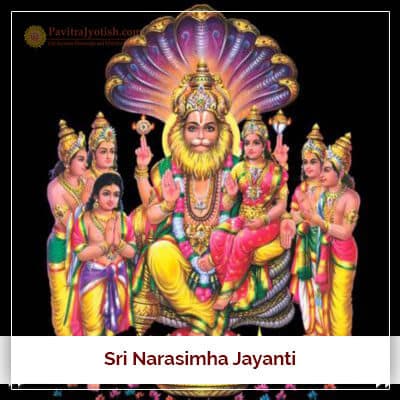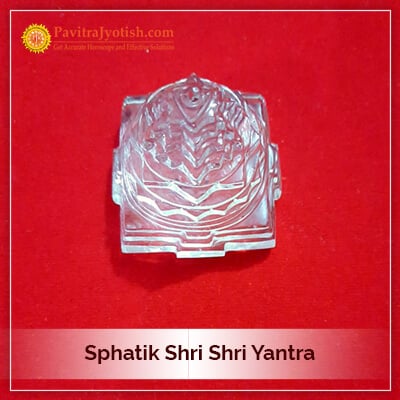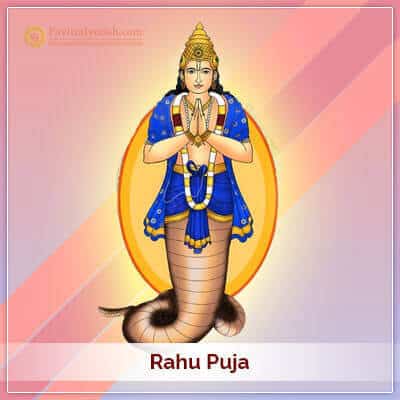Narasimha Jayanti
Published On : April 15, 2024 | Author : Astrologer Pt Umesh Chandra Pant 
Narasimha Jayanti And Its Significance
The incarnation of Narasimha of Lord Vishnu happened to put an end to the injustice and save the sanctity and fabric of religion on earth. The reason why Lord Vishnu is considered a precursor to the various incarnations is based on the fact that his incarnations had the immeasurable power with which demonic forces could be destroyed to restore peace and justice. Lord Vishnu, who is also called Dayanidhi (kind) and Kripa Sindhu (deeply compassionate), protects his devotees from all conceivable forms of threats. Regardless the circumstances in which a devotee finds himself trapped that may pose a serious threat to his life, Lord Vishnu, comes to his rescue in any incarnation, at any cost. Lord Vishnu is the destroyer of all miseries. Therefore, Narasimha Jayanti is celebrated all over India by the devotees joyfully as the festival protecting the humankind and religion. Besides India, the festival of Narasimha Jayanti is also celebrated in other parts of the world, with Hindu followers. The celebration of Narasimha Jayanti takes place on Shukla Paksha of Chaturdashi Tithi during Vaishakh month. On this day, Bhandaras for people at various famous temples is organized. People enjoy Prasad at these Bhandaras. Because of the effects of worshipping Narasimha on his Jayanti, obstacles and fear of spooky elements get destroyed in a devotee’s life. Because, this is the day commemorating Lord Vishnu, as Lord Narasimha, came to the rescue of his staunch devotee, Prahalada. The timely intervention of Lord Vishnu as Narasimha saved the dear life of Prahalada.
Methods To Follow During Narasimha Jayanti
Lord Narasimha, a great nourisher and protector of devotees, must be worshipped religiously and with utmost reverence on Narasimha Jayanti. Therefore, purity of one’s individuality before celebrating Narasimha Jayanti is extremely important. In this context, devotees, after attending daily routines, taking a bath, and wearing a fine outfit, are supposed to collect all Puja-related materials and keep them in order at a sacred place. Maintain a posture facing the eastern or southern side, with no sign of anger and hastiness, and remember God. Sprinkle holy water on yourself (Achamana). Recite mantra for self-purification. Lit incense sticks and diyas. Ensconce a Kalash and an idol of the god. Proceed with Pujan either at a temple of god Narasimha or in front of the idol of Lord Vishnu at your home. Recite auspicious mantras for the puja. Take vows for your puja and vrat. Continue Narasimha Jayanti puja with Shodashopachar methods (it involves worshipping a god by using sixteen different types of things to be offered to the lord).
Story Of Narasimha Jayanti
There are countless mythological tales and references in Vedas and Puranas about the genesis of lord Narasimha. One of them talks at length about how lord Narasimha came into being. The legend has it that once there lived a famous king named Kashyapa. He had a wife called Diti and two sons, Hiranyaksh and Hiranyakashyapa. The sons gained notoriety all over Triloka because of their unbridled demonic nature of launching tyranny on the innocents. Not only this, Hiranyaksh even dared to take the earth to the underworld. However, it was rescued by Lord Vishnu’s incarnation, Varaha by slaying Hiranyaksh. The death of Hiranyaksh infuriated his brother, Hiranyakashipu who vowed to avenge his death from Lord Vishnu. For this, he stopped all Vedic-related works on earth, causing insufferable tyrannies to humankind. He became petulant and got easily provoked the moment he hears the name of Hari or Vishnu. However, the divine miracle of Lord Vishnu happened in such a way that Hiranyakashipu had a son called Prahalada who was extremely pious and devotee to Lord Vishnu, the name he hated to hear.
Young Prahalada dedicated his life to the staunch devotion of Lord Vishnu. When he was studying, he never forgot to remember Lord Vishnu. Later, Hiranyakashipu came to know about his son’s undying devotion to Shri Hari through his teachers. Enraged, he tried to convince his son not to follow the devotions of Shri Hari but all his efforts bore no fruit as the son didn’t yield and kept on praying to Lord Hari. To handle the situation, Hiranyakashipu had his son thrown in front of an enraged elephant to trample him to death, but he was saved due to the mercy of Lord Hari. Hiranyakashipu tried various ways of killing his son and every time he experienced the taste of defeat. Finally, he tied his son to a pillar and asked him angrily to call his protector, Lord Hari.
Hiranyakashipu was convinced that he was immune to death due to the boon given to him by Lord Brahma. According to the boon, he wouldn’t be killed by an animal or a human, nor in a day or at night, neither indoors nor outdoors. That’s why Lord Vishnu assumed the form of a creature who was partly human and partly animal. Besides, he attacked Hiranyakashipu when it was twilight and the place he chose was the threshold of a courtyard (meaning neither indoors nor outdoors). Interestingly, the new incarnation of Lord Vishnu as Narasimha put Hiranyakashipu on his thigh, signifying the demon was neither on earth nor in the air). Lastly, he was killed by the claws of Lord Narasimha, signifying the demon was killed by something which was not a human weapon.
The form of Lord Vishnu as Narasimha is considered to be the remover of all obstacles and giver of desired results in the life of his devotees.
Must Read:
Chinnamastika Jayanti and Janaki Bhagwati Jayanti

























